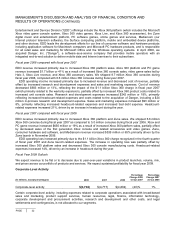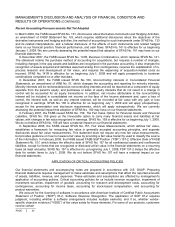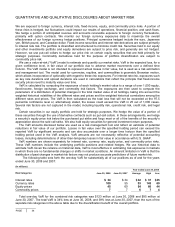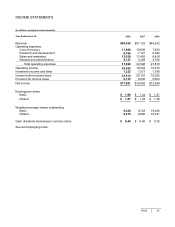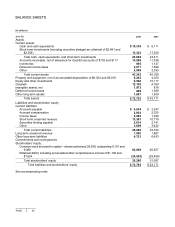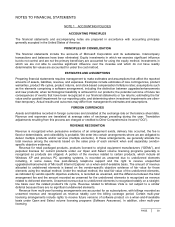Microsoft 2008 Annual Report Download - page 31
Download and view the complete annual report
Please find page 31 of the 2008 Microsoft annual report below. You can navigate through the pages in the report by either clicking on the pages listed below, or by using the keyword search tool below to find specific information within the annual report.
PAGE 30
MANAGEMENT’S DISCUSSION AND ANALYSIS OF FINANCIAL CONDITION AND
RESULTS OF OPERATIONS (CONTINUED)
Recent Accounting Pronouncements Not Yet Adopted
In March 2008, the FASB issued SFAS No. 161, Disclosures about Derivative Instruments and Hedging Activities,
an amendment of FASB Statement No. 133, which requires additional disclosures about the objectives of the
derivative instruments and hedging activities, the method of accounting for such instruments under SFAS No. 133
and its related interpretations, and a tabular disclosure of the effects of such instruments and related hedged
items on our financial position, financial performance, and cash flows. SFAS No. 161 is effective for us beginning
January 1, 2009. We are currently assessing the potential impact that adoption of SFAS No. 161 may have on our
financial statements.
In December 2007, the FASB issued SFAS No. 141R, Business Combinations, which replaces SFAS No. 141.
The statement retains the purchase method of accounting for acquisitions, but requires a number of changes,
including changes in the way assets and liabilities are recognized in the purchase accounting. It also changes the
recognition of assets acquired and liabilities assumed arising from contingencies, requires the capitalization of in-
process research and development at fair value, and requires the expensing of acquisition-related costs as
incurred. SFAS No. 141R is effective for us beginning July 1, 2009 and will apply prospectively to business
combinations completed on or after that date.
In December 2007, the FASB issued SFAS No. 160, Noncontrolling Interests in Consolidated Financial
Statements, an amendment of ARB No. 51, which changes the accounting and reporting for minority interests.
Minority interests will be recharacterized as noncontrolling interests and will be reported as a component of equity
separate from the parent’s equity, and purchases or sales of equity interests that do not result in a change in
control will be accounted for as equity transactions. In addition, net income attributable to the noncontrolling
interest will be included in consolidated net income on the face of the income statement and, upon a loss of
control, the interest sold, as well as any interest retained, will be recorded at fair value with any gain or loss
recognized in earnings. SFAS No. 160 is effective for us beginning July 1, 2009 and will apply prospectively,
except for the presentation and disclosure requirements, which will apply retrospectively. We are currently
assessing the potential impact that adoption of SFAS No. 160 may have on our financial statements.
In February 2007, the FASB issued SFAS No. 159, The Fair Value Option for Financial Assets and Financial
Liabilities. SFAS No. 159 gives us the irrevocable option to carry many financial assets and liabilities at fair
values, with changes in fair value recognized in earnings. SFAS No. 159 is effective for us beginning July 1, 2008.
We do not believe SFAS No. 159 will have a material impact on our financial statements.
In September 2006, the FASB issued SFAS No. 157, Fair Value Measurements, which defines fair value,
establishes a framework for measuring fair value in generally accepted accounting principles, and expands
disclosures about fair value measurements. This statement does not require any new fair value measurements,
but provides guidance on how to measure fair value by providing a fair value hierarchy used to classify the source
of the information. In February 2008, the FASB issued FASB Staff Position (“FSP”) 157-2, Effective Date of FASB
Statement No. 157, which delays the effective date of SFAS No. 157 for all nonfinancial assets and nonfinancial
liabilities, except for items that are recognized or disclosed at fair value in the financial statements on a recurring
basis (at least annually). SFAS No. 157 is effective for us beginning July 1, 2008; FSP 157-2 delays the effective
date for certain items to July 1, 2009. We do not believe SFAS No. 157 will have a material impact on our
financial statements.
APPLICATION OF CRITICAL ACCOUNTING POLICIES
Our financial statements and accompanying notes are prepared in accordance with U.S. GAAP. Preparing
financial statements requires management to make estimates and assumptions that affect the reported amounts
of assets, liabilities, revenue, and expenses. These estimates and assumptions are affected by management’s
application of accounting policies. Critical accounting policies for us include revenue recognition, impairment of
investment securities, impairment of goodwill, accounting for research and development costs, accounting for
contingencies, accounting for income taxes, accounting for stock-based compensation, and accounting for
product warranties.
We account for the licensing of software in accordance with American Institute of Certified Public Accountants
Statement of Position (“SOP”) 97-2, Software Revenue Recognition. The application of SOP 97-2 requires
judgment, including whether a software arrangement includes multiple elements, and if so, whether vendor-
specific objective evidence (“VSOE”) of fair value exists for those elements. For some of our products, customers
receive certain




